How to prevent—or deal with—hearing loss
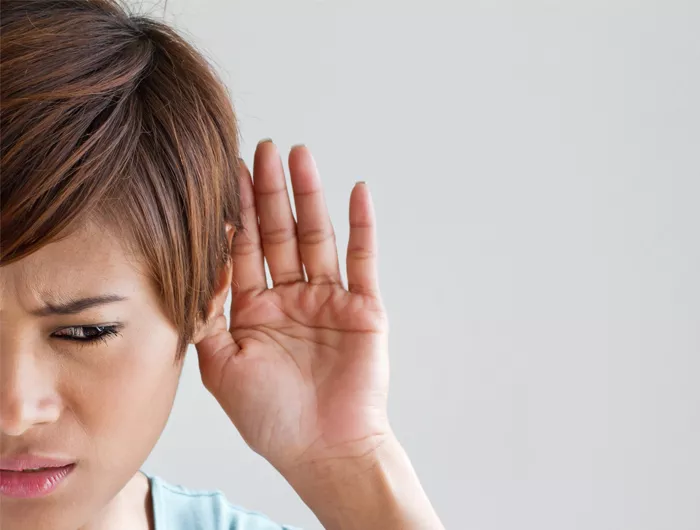
Sound World Solutions
Age takes a toll on your ears. A quarter of people in their 60s, and two-thirds of those aged 70 and up, have trouble hearing. That works out to 30 million of us...and counting.
But hearing loss isn’t inevitable. Here’s what may protect your hearing ...and what new devices can help when it’s hard to hear.
Hearing 101
“Hearing depends on two basic processes,” says Frank Lin, associate professor of otolaryngology at the Johns Hopkins University School of Medicine.
The first step occurs in the cochlea, a cavity in the inner ear that looks like a snail shell.
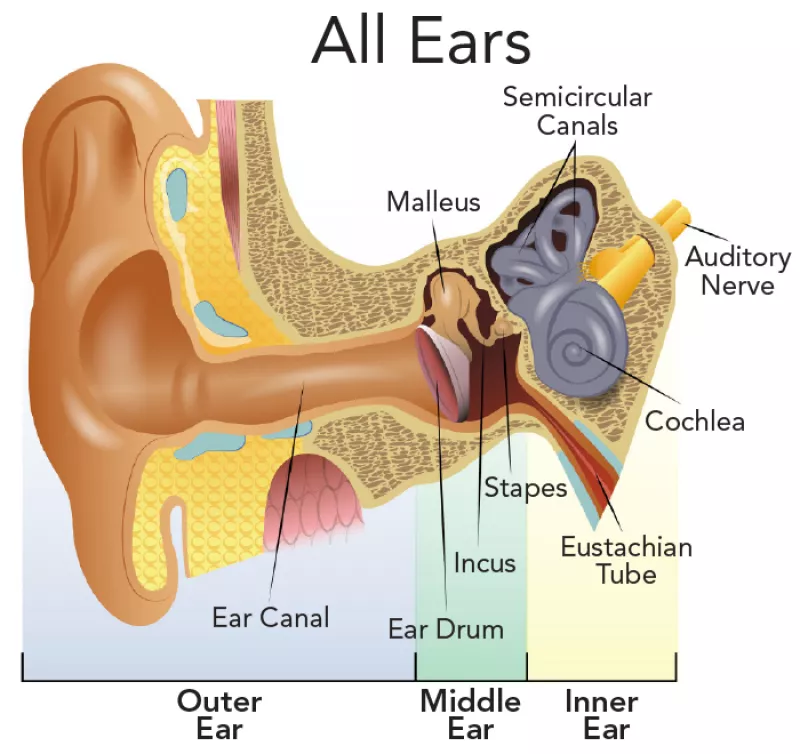
“The cochlea takes in sound vibrations and converts them into a neural signal,” explains Lin. Then the auditory nerve sends those signals to the brain for decoding.
“When we talk about hearing loss as we age, we’re talking about damage to the cochlea over time,” says Lin. The cochlea starts to fail, and no one has figured out how to repair it.
“That doesn’t necessarily mean you can’t hear,” notes Lin. “It means that instead of sending this crystal clear signal, the cochlea sends a much more garbled signal to the brain.”
So you can hear someone talking, but you have trouble detecting the words.
“It’s as though you’re trying to have a conversation on a cell phone while walking down a busy street,” says Lin.
“You may still make out what is being said, but it doesn’t sound as clear.”
Some people don’t even realize that their hearing is on the fritz.
“People will say things like, ‘I don’t have hearing loss—my wife mumbles all the time,’” says Lin. “That’s what it sounds like, so it’s very easily ignored.”
Clues to protect ears
What intrigues researchers is that although hearing loss is common, it’s not universal.
“When we started our studies in the early ‘90s, people thought this was a normal part of aging—that it was inevitable, and that everyone would experience these problems as [they got] older,” Karen Cruickshanks, a professor at the University of Wisconsin School of Medicine and Public Health, told students in a September lecture.
“Over the course of the work here in Wisconsin, we’ve discovered how not true that is.”
Cruickshanks is a leader of both the Epidemiology of Hearing Loss Study and the Beaver Dam Offspring Study, which examine a total of roughly 7,000 participants every five years for changes in hearing, vision, memory, and more.
On average, in the two studies, hearing declined with age. But that average “is made up of two populations—a group that does really well over time and a group that has clinically significant hearing loss,” said Cruickshanks.
That led her to ask: If hearing loss “is not normal aging, then what’s causing that decline in function over time?”
So her team started to look at what distinguishes people who lose their hearing from those who don’t. Among her findings: male ears are at greater risk.1
“Men are about twice as likely to develop hearing impairment as women, and they get it a little bit earlier,” said Cruickshanks. “Women have about six more years of healthy hearing than men do.”
Years in school also matter. “If you had less education, you were more likely to develop a hearing loss,” she explained.
Noise on the job didn’t seem to matter, even though loud noise can damage the cochlea. (See “How Loud Is Too Loud?”) However, people are less exposed to noise at work than they were 50 years ago, thanks to a shift from blue collar to white collar jobs and regulations that require workers to wear earplugs or other devices that protect their ears.
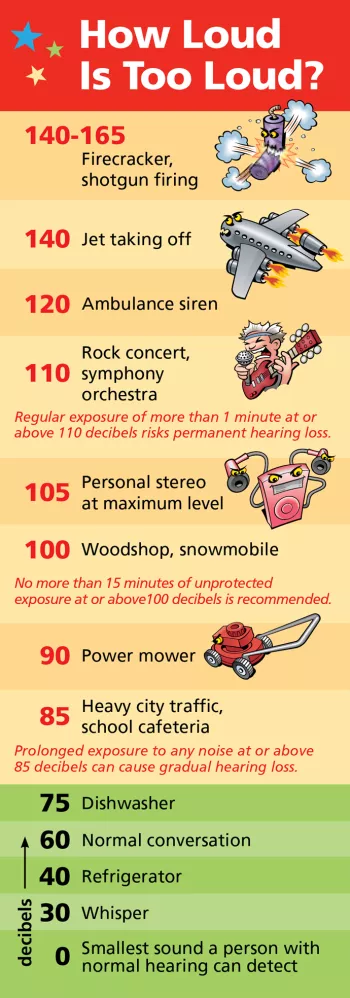
“In addition to those age, sex, and education factors, adiposity—your waist circumference—was a predictor of developing hearing loss,” noted Cruickshanks.
Smokers were also at higher risk, as were people with poorly controlled diabetes.1
People who were highly educated, never smoked, and had normal weight and blood sugar had a lower risk. But for men, the risk was “almost double if you have all of the risk factors,” explained Cruickshanks. And it almost triples if you’re a woman.
Cruickshanks also found a higher risk of hearing loss in people with more atherosclerosis (artery clogging) in their carotid (neck) arteries.2
“If you had plaque, a more severe manifestation of atherosclerotic disease,” said Cruickshanks, the risk rose by 16 percent for each plaque site.
People with higher levels of low-grade inflammation over long periods of time were also at increased risk.3 In an Australian study, hearing declined faster in people with high blood pressure.4
And in the Nurses’ Health Studies, “we found that women who walked at least four hours a week had a 15 percent lower risk of hearing loss,” says Sharon Curhan, a Harvard Medical School and Brigham and Women’s Hospital physician and epidemiologist.5
But overall, we’re in the early stages of research into hearing loss. Until more studies track people over time, these findings are still a work in progress.
Diet and hearing
Could certain foods or nutrients affect your hearing? Only a handful of studies have looked, but they offer some tantalizing clues:
Folate
"In our studies, people who had higher intakes of folate over time had a lower risk of hearing loss," says Curhan.6,7
That’s backed up by a Dutch study that gave 728 older men and women either a high dose of the B vitamin (800 micrograms a day) or a placebo for three years.8
“Individuals who received the folate had a slower decline in their hearing sensitivity,” says Curhan, who is a leader of the Conservation of Hearing Study (CHEARS).
However, the Dutch food supply wasn’t fortified with folic acid, like ours is. “It’s much harder to find people in the U. S. who have very low intakes of folate,” says Curhan.
(Fruits, vegetables, and beans are rich in folate. Since 1998, the B vitamin has been added to most breads, cereals, pasta, and other foods made with refined grains. That fortification has cut the risk of spina bifida and other neural tube birth defects by nearly 30 percent.)
Omega-3 fats
Curhan's team also found that nurses who reported eating fish two to four times a week had a 20 percent lower risk of hearing loss than those who ate less than one serving a month.9 The omega-3 fats in fish may explain why.
“A higher intake of omega-3 fats may improve blood flow to the cochlea,” suggests Curhan. “The cochlea is highly metabolically active, so it is critically dependent on having an adequate blood supply.”
What’s more, she adds, “omega-3 fats help stabilize cell membranes so they become less vulnerable to injury, and they may help protect against inflammation and blood clots.”
Still, says Curhan, “it’s hard to disentangle what’s due to omega-3s and what’s due to fish, which is a rich nutritional package.”
Carotenoids
Among women—but not men—those who consumed the most beta-carotene and beta-cryptoxanthin had a lower risk of hearing loss.6,7 Both carotenoids are found in fruits and vegetables. Why might they matter?
“The ear works so hard, and it has such a high metabolic rate, that it can generate byproducts of metabolism that can be potentially toxic,” explains Curhan. “Beta-carotene and beta-cryptoxanthin are effective antioxidants that may help prevent that damage.”
Vitamin C
“We found that women who consumed at least 1,000 milligrams a day of vitamin C, mostly from supplements, had a 22 percent higher risk of hearing loss,” says Curhan.6 But the link didn’t show up in men.7
Overall, the data on diet and hearing is still emerging. “For a long time, hearing loss was considered an inevitable part of aging,” says Curhan, “but it’s becoming more and more clear that there may be things that we can do to prevent or delay it.”
Hearables
In the meantime, if you’re having trouble hearing, you’re not alone.
“By the time we get to 70 and above, two out of every three Americans has a clinically meaningful hearing impairment,” says Johns Hopkins’ Frank Lin. “But the rate of hearing aid use is phenomenally low—about 15 percent of those who need one.”
That’s partly because Medicare and most insurance plans don’t cover hearing aids. So consumers have only one option: pay out of pocket for hearing aids that are bundled with services.
“You plunk down a bunch of money for upfront costs and for visits back and forth to an audiologist or a technician trained to fit hearing aids,” explains Lin.
“And the average cost is $4,000 to $5,000, which is absurd. That model is good for people who have more complicated kind of hearing loss, so they need a lot of customization. But many others don’t.”
Take a 60-year-old who has trouble hearing only in noisy settings, says Lin. “They don’t want to go through that whole process just to get a hearing device that they need only part of the time.”
That’s where over-the-counter personal sound amplifiers may help. (Scroll down to “Psst...Wanna try a PSAP?” for more.) The problem: many are junk.
“The vast majority of devices you see in the back of magazines—the ones that say ‘$50 miracle device!’—are complete garbage,” Lin cautions. “They just make everything louder. The sound quality is terrible. Those companies are just out to make a buck.”
In contrast, he notes, “a few are excellent, but consumers don’t know which are good and which are bad.”
Lin recently served on a National Academy of Medicine Committee on Accessible and Affordable Hearing Health Care for Adults. One of its recommendations: the Food and Drug Administration should create a category of over-the-counter “wearable hearing devices” that meet basic standards.10
(Lin is on a scientific advisory board for the drug company Pfizer, serves on a safety monitoring board for Autifony, a company that develops drugs for hearing loss, and has a research grant from Cochlear Ltd, which designs and manufactures cochlear implants. He has no financial ties to any PSAP makers.)
“If you buy a pair of reading glasses at a drugstore, you know they’re going to work to a certain degree,” says Lin.
Once the FDA sets benchmarks for PSAPs, big box stores might carry them, and people could shop for the best.
“It would be like buying a new phone,” says Lin. “You’d see a plethora of ratings in places like Consumer Reports.”
Psst...Wanna try a PSAP?
Cost, stigma, inconvenience. Those and other barriers may explain why millions of Americans with impaired hearing don’t use hearing aids. Could over-the-counter PSAPs—personal sound amplification products—fill the gap? Here’s a guide to choosing and using them.
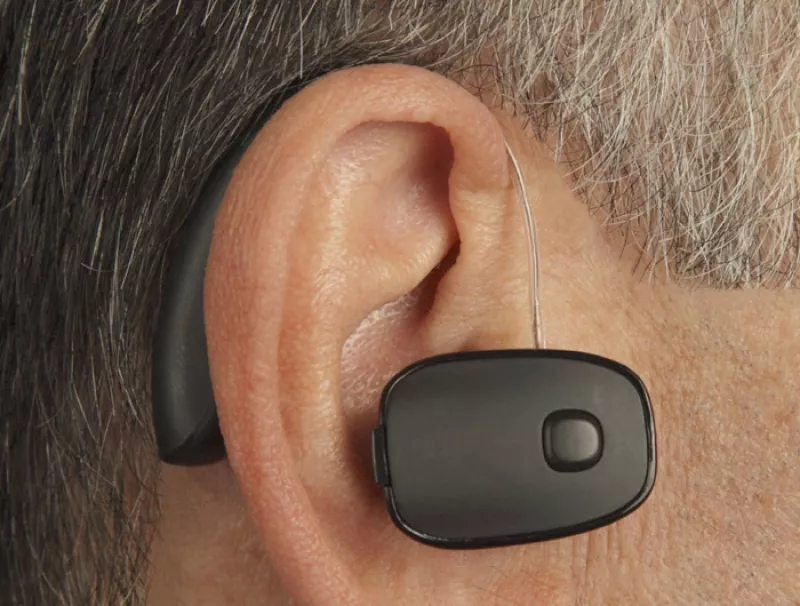
What’s the difference between a hearing aid and a PSAP?
“PSAPs are devices that amplify sound but are not marketed for hearing loss,” explains Nicholas Reed, an audiologist and research fellow at Johns Hopkins University. “They can be marketed for things like improving your hearing if you’re a hunter or you want to hear better at a concert or a noisy restaurant.”
Any device that’s marketed for someone with hearing loss would be regulated by the Food and Drug Administration as a hearing aid.
“Other than the marketing, PSAPs can have some of the exact same interior circuitry, and they can do the same things” as hearing aids, says Reed.
At least that’s true for people with mild to moderate hearing loss.
“Once you get into the severe to profound hearing loss range, you need a hearing aid,” notes Reed. “Hearing aids can amplify a lot of sound without a ton of distortion. Most PSAPs couldn’t handle that. They would just be squealing with noise.”
And PSAPs can’t adjust as easily from one situation to another.
“A hearing aid can see you through everything from the theater to a boardroom to sitting quietly in the park or at home with your family. PSAPs aren’t going to move across these situations so fluently,” explains Reed.
“In the future, they may. But right now, the hearing aid is vastly superior when it comes to situational fluidity.”
There’s another difference: PSAPs typically cost $200 to $450 per ear, far less than hearing aids, which average $4,700 per pair. But with no regulations, there’s no way for you to know how well a PSAP works. That’s what led Reed to test them.
Testing, testing...
How can people tell which PSAPs are good? “That’s the million-dollar question,” says Reed. So his lab started with the most basic, electroacoustic tests.
“Electroacoustic testing means you basically hook up a microphone on the device, put in sound, and measure the output,” he says.
“If a device amplifies sound across a good frequency range and doesn’t provide a ton of distortion or internal noise, it basically meets the minimum standard for what a hearing aid should do.”
Some PSAPs are so terrible that they make hearing worse.
“One device we tested amplifies only a few very low frequencies, and it adds a ton of distortion and internal noise levels and feedback, so it’s like hearing a motor in your ear,” says Reed. “People hear better with nothing than with that device.”
Now Reed, who works with Hopkins’ Frank Lin, is testing PSAPs on people.
“The patient goes into a booth, and we produce a lot of background noise, just like you’d hear in a restaurant, and then we present sentences to them, and they repeat them,” says Reed.
“The next step is testing them in the real world. But in our very controlled setting, we’re finding that a couple of the devices are comparable to hearing aids.”
The only one currently available: the Sound World Solutions CS50+.
The set-up
You can buy a PSAP online from the manufacturer or Amazon. To customize it, you may need a smartphone.
“Most people who are savvy with a smartphone can follow the instructions,” says Reed.
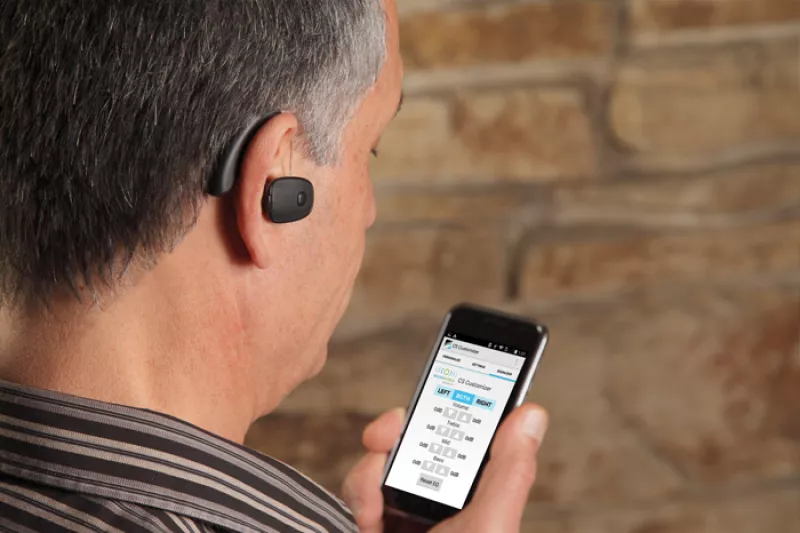
But beware of a common error. “Most hearing loss is high frequency,” notes Reed. “That takes away the clarity of sound, but not the volume.”
But most people turn up the bass (the low frequency), because that sounds like they’re turning up the volume.
“If you turn up the bass on your car stereo, you really notice it,” says Reed. “But if you turn up the treble, which adds clarity, you have to pay attention to notice it. So most people should turn up the high frequencies and let the lows sit where they are.”
Some PSAPs, like the Sound World Solutions CS50+, look like a Bluetooth headset—a device that connects wirelessly to a cellphone. “What a great idea,” says Reed. “It looks slick and completely removes any stigma.“ Bonus: You can use it to talk or listen to music on your cell phone.
The bottom line: PSAPs could help the millions of people who aren’t getting hearing aids.
“They may not have the access, the awareness, or the funds to pursue hearing aids,” says Reed. “And many people in their 50s and 60s aren’t ready to admit that they’re starting to experience hearing loss.“
“PSAPs would be fantastic for those people because they can get a relatively inexpensive device that would improve the quality of their lives.”
The National Hearing Test
Want to take a quick screening test for hearing loss by phone?
The National Hearing Test—created with funding from the National Institutes of Health—costs only $5. It tests how well you can hear speech with noise in the background. You’ll need a landline (not a cell phone) and a quiet room. Ready? Go to nationalhearingtest.org.
The bottom line
Avoid loud noises.
Don't smoke.
Keep a lid on your blood sugar.
Lose (or don't gain) excess pounds.
Aim for 30 to 60 minutes a day of exercise like brisk walking.
Fill half your plate with fruits and vegetables.
Eat fish twice a week.
References
1J. Am. Geriatr. Soc. 63: 918, 2015.
2Atherosclerosis 238: 344, 2015.
3J. Gerontol. A Biol. Sci. Med. Sci. 69: 207, 2014.
4J. Gerontol. A Biol. Sci. Med. Sci. 67: 997, 2012.
5Am. J. Med. 126: 1142.e1, 2013.
6Am. J. Clin. Nutr. 102: 1167, 2015.
7Otolaryngol. Head Neck Surg. 142: 231, 2010.
8Ann. Intern. Med. 146: 1, 2007.
9Am. J. Clin. Nutr. 100: 1371, 2014.
10nationalacademies.org/hmd/Reports/2016/Hearing-Health-Care-for-Adults.aspx.
Photos: Sound World Solutions. Illustrations: © pablofdezr/fotolia.com (inner ear), NIH (noises).
Tags
Topics

